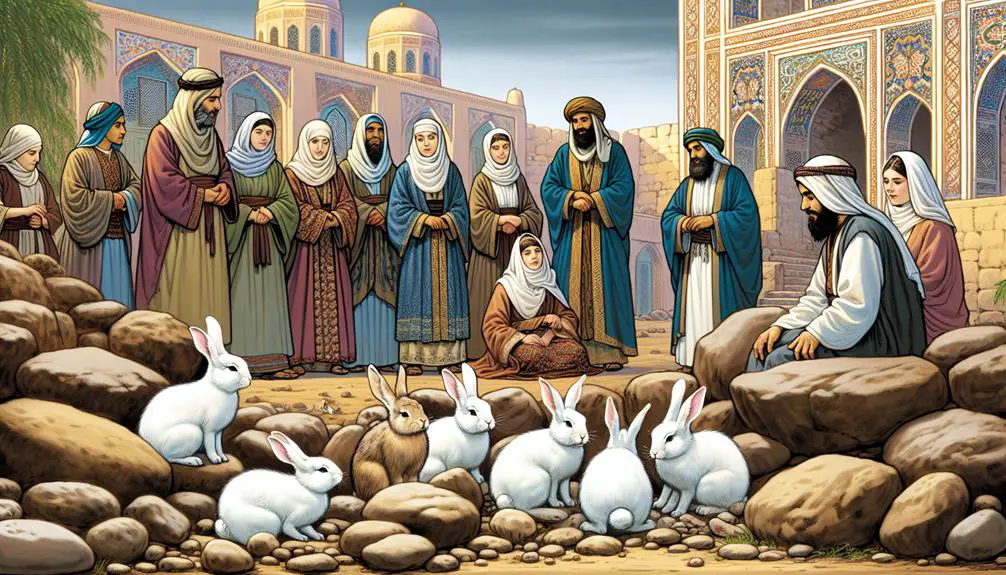Kneeling in biblical landscapes, conies emerge as symbols of wisdom, urging us to delve deeper into their spiritual significance.

Conies in the Bible
In biblical texts, conies are more than just small creatures scurrying in the shadows; they embody lessons of wisdom and survival that remain pertinent today.
You'll find these animals nestled within the scriptures, serving as symbols that carry a weight beyond their physical presence.
As we unpack their identity and the layers of meaning behind their mention in ancient texts, you'll discover how conies have influenced not only religious teachings but also cultural perceptions throughout history.
This exploration offers a unique lens through which to view the interplay between nature and spirituality, inviting you to uncover insights that resonate with contemporary life.
Key Takeaways
- Conies, or rock hyraxes, symbolize wisdom and vulnerability in biblical texts.
- Their adaptation to rocky terrains highlights resilience and strategic living.
- Biblical references to conies enrich understanding of ancient ecosystems and virtues.
- Modern interpretations of conies emphasize conservation and ethical stewardship.
The Identity of Conies

The term 'conies' in the Bible refers, with considerable certainty, to a species of small, herbivorous mammals known scientifically as Procavia capensis, commonly called rock hyraxes. You'll find that their dietary habits are quite fascinating and indicative of their adaptability and survival strategy in harsh environments. Rock hyraxes primarily feed on a variety of vegetation, including leaves, fruits, and bark, which is readily available in their natural habitats (Kunhardt, 2015). This diet reflects their ecological niche and how they've adapted to make the most of the resources available to them.
Moreover, their habitat adaptation is equally remarkable. Rock hyraxes are known to inhabit rocky terrains in parts of Africa and the Middle East, utilizing crevices and caves for shelter (Bar-David et al., 2006). This choice of habitat isn't arbitrary; it provides protection from predators and extreme weather conditions, demonstrating a high level of environmental adaptation. Their ability to thrive in such habitats is linked to their social structures and behaviors, which include basking in the sun to regulate body temperature and living in colonies for better protection and resource allocation (Hetem et al., 2009).
In analyzing the identity of conies as described in the Bible, it's evident that their dietary habits and habitat adaptation are key factors that have enabled their survival and proliferation in diverse and often challenging ecosystems. These aspects underpin the scholarly understanding of conies and contribute to our broader knowledge of biblical natural history.
Biblical References Explained

You'll find conies referenced in the Bible as symbols of vulnerability and wisdom, reflecting their characteristics and societal perceptions during ancient times (Proverbs 30:26).
Scholars have analyzed these ancient text descriptions, noting the conies' significance in biblical ecosystems and narratives.
Modern interpretations continue to explore how these references resonate with contemporary themes of survival and adaptability.
Conies' Symbolic Meaning
In biblical texts, conies symbolize wisdom and vulnerability, as evidenced by their mention in Proverbs 30:26. These creatures, while physically weak, display a profound understanding of their environment to survive. This paradoxical nature of conies serves as a powerful metaphor in scriptural teachings, emphasizing that strength often comes from wisdom and understanding rather than physical might.
- Conies' Diet: Primarily vegetation-based, showcasing their adaptability and resourcefulness.
- Habitat Specifics: Rocky terrains, which provide natural fortifications against predators.
- Symbolic Interpretation: Reflecting on their survival strategies, conies embody the wisdom of choosing one's battles and the strength found in vulnerability and adaptability.
This scholarly analysis reveals how conies, through their diet and habitat, serve as a biblical symbol for wisdom in vulnerability, guiding readers toward a deeper understanding of spiritual strength.
Ancient Text Descriptions
Having explored the symbolic significance of conies in biblical texts, let's now examine the specific passages where these creatures are mentioned and uncover the deeper meanings behind those references.
The translation challenges surrounding the term 'conies' highlight the complexity of interpreting ancient scriptures. Scholars debate the accuracy of translations, influenced by evolving linguistic understanding and archaeological findings.
These findings, in turn, offer insights into the habitats and characteristics of conies, providing context that enriches our comprehension of biblical references. Such scholarly efforts demonstrate the intricate process of translating and interpreting ancient texts, ensuring that modern readers grasp the nuanced significance of conies as portrayed in the Bible, beyond their literal presence to their symbolic and cultural implications.
Modern Interpretations
Delving into modern interpretations, scholars reveal that biblical references to conies encompass profound symbolic meanings, intricately woven into the fabric of ancient texts. These creatures aren't just literal fauna; they serve as metaphors and teaching tools within scripture. Here's what you'll find most fascinating:
- Ecological perspectives: Conies are highlighted to showcase the delicate balance of nature and humanity's role within it.
- Dietary laws: Their mention underscores the complexities and spiritual intentions behind the dietary regulations laid out in Leviticus.
- Symbolic representation: Conies symbolize vulnerability and the need for protection, mirroring the spiritual care God offers to His people.
Through these lenses, conies in the Bible aren't merely animals; they're vehicles for deeper understanding and reflection.
Symbolism and Significance

You'll find that conies in the Bible aren't merely animals but embody a complex web of symbolism and significance.
Scholars such as Harrington (2015) argue that their imagery is deeply rooted in spiritual meanings, offering unique insights into the text's cultural and religious contexts.
This analysis will unpack the layers of conies' representation, from their Biblical imagery to their enduring cultural impact, providing a comprehensive understanding of their role in scripture.
Conies' Biblical Imagery
In biblical texts, conies symbolize vulnerability and wisdom, reflecting their ecological characteristics and societal perceptions during ancient times. These small, timid creatures, despite their fragility, exhibit a profound understanding of their environment, which is crucial for their survival. This duality makes them fascinating symbols in scripture, inviting a deeper exploration of their significance.
- Conies' diet: Primarily herbivorous, their feeding habits are indicative of their adaptability and resourcefulness.
- Habitat specifics: They dwell in rocky terrains, illustrating their preference for environments that offer protection and challenge.
- Societal perceptions: In ancient times, conies were seen as wise for their survival strategies, despite their physical vulnerabilities.
This imagery underscores a nuanced understanding of strength, wisdom, and vulnerability, revealing the depth of biblical symbolism through the natural world.
Spiritual Meanings Explored
Often, conies in the Bible are imbued with rich spiritual meanings, reflecting their roles as symbols of wisdom and vulnerability that resonate deeply within the fabric of biblical narratives.
Their specific habitat in rocky terrains and their herbivorous diet, primarily consisting of plants and grasses, serve as metaphors for the spiritual nourishment and protection provided by faith. Just as conies rely on the safety of rocks for shelter, believers are encouraged to find refuge in their spiritual beliefs.
The conies' diet, emphasizing simplicity and sustenance, symbolizes the purity and sufficiency of spiritual food that nurtures the soul. Thus, conies in biblical texts aren't merely animals but carry profound symbolic significance, illustrating lessons of reliance, humility, and spiritual sustenance.
Cultural Impact Analysis
Many cultures have interpreted the symbolism of conies in the Bible, seeing them as emblems of wisdom and vulnerability that deeply influence spiritual and societal perceptions.
- Conies' Diet: Reflects adaptability and resourcefulness, mirroring virtues appreciated in human society.
- Habitat Preservation: Symbolizes the importance of stewardship and care for the environment, a moral lesson extracted from their biblical representation.
- Spiritual Significance: Conies are portrayed as creatures of humility, teaching lessons of reliance on community and divine protection.
This analysis shows how conies in the Bible transcend their literal existence, contributing to a richer understanding of virtues and environmental ethics. Their portrayal not only highlights their ecological role but also their metaphorical significance, underscoring the interconnectedness of natural wisdom and spiritual insight.
Conies in Ancient Cultures

Throughout ancient cultures, conies held significant symbolic and practical roles, reflecting diverse societal values and beliefs. Their preference for rock dwellings not only highlights their unique adaptation to harsh environments but also carries symbolic meanings in various cultures. In some traditions, the conies' ability to thrive in the cracks and crevices of mountains symbolized resilience and wisdom, teaching humans the virtue of making the most out of one's surroundings, no matter how harsh or unforgiving.
Moreover, the dietary habits of conies were closely observed and often imbued with cultural significance. As herbivores, their diet consists mainly of grasses and herbs, which in some cultures symbolized purity and simplicity. This dietary preference led to them being considered clean animals in certain ancient dietary laws, reflecting on their broader cultural and religious significance.
Archaeological findings, such as remnants of conies' bones in ancient settlement layers, provide evidence of their role in the diet of some communities. Yet, in other cultures, their consumption was taboo, illustrating the complex and varied attitudes towards conies across different societies.
Analyzing the presence and significance of conies in ancient cultures reveals a multifaceted relationship between humans and these small creatures. Their adaptation to living in rock dwellings and their specific dietary habits not only contributed to their survival in diverse environments but also influenced the cultural and religious practices of the humans who lived alongside them.
Lessons From the Conies

Reflecting on the multifaceted relationship between humans and conies in ancient cultures, it becomes evident that these small creatures offer valuable lessons on resilience, adaptation, and the importance of understanding our natural environment. Through their existence, conies demonstrate remarkable strategies to thrive despite the adversities they face, particularly in their habitats and when confronting predatory challenges.
Conies, known for their preference for rocky terrains, teach us the significance of adapting to one's environment. Their choice of habitat not only provides them with shelter but also a strategic advantage against predators. This adaptation underscores the importance of utilizing available resources and conditions to one's benefit, a lesson applicable in various human endeavors.
Moreover, the survival tactics of conies against predatory challenges highlight the value of vigilance and community cooperation. These creatures often work together to warn each other of impending dangers, showcasing the strength found in collective effort and mutual support.
To encapsulate:
- Conies' habitats illustrate the necessity of adaptation and the clever use of one's surroundings for protection and sustenance.
- Predatory challenges faced by conies emphasize the importance of vigilance, community, and strategic thinking for survival.
- Resilience and adaptation are key themes observed in the life of conies, offering profound lessons on overcoming adversity.
In essence, the study of conies within their natural contexts reveals insightful parallels to human strategies for dealing with challenges. Their ability to adapt and thrive in harsh environments, coupled with their communal approach to survival, provides a rich source of inspiration and learning for humans navigating their own complexities.
Modern Interpretations

In contemporary discourse, scholars have reevaluated the significance of conies, drawing intriguing parallels between ancient insights and modern environmental challenges. You're stepping into a domain where ecological perspectives intersect with theological debates, highlighting how these creatures once considered mere symbols of vulnerability and wisdom now inform our understanding of biodiversity and conservation.
Aspect |
Ancient Insight |
Modern Interpretation |
|---|---|---|
Symbolism |
Weakness, Wisdom |
Conservation, Ecosystem Balance |
Habitat |
Rocky terrains, Deserts |
Biodiversity hotspots, Fragile ecosystems |
Behavior |
Community-oriented, Hiding |
Social structures, Adaptation strategies |
Ecological Role |
Overlooked |
Keystone species, Habitat engineers |
Theological |
Humility, Dependence on God |
Stewardship, Ethical environmentalism |
You'll find that the conies' habitat, once merely a backdrop for biblical lessons on humility and reliance on divine protection, is now seen through the lens of ecological importance. These areas are recognized as biodiversity hotspots that require urgent conservation efforts.
Moreover, their behavior, reflecting social structures and sophisticated adaptation strategies, offers valuable lessons for understanding the resilience and vulnerability of ecosystems. This shift in perspective underscores the importance of integrating ecological insights into theological debates, fostering a holistic stewardship ethos that honors creation's complexity.
The conies, thus, serve as a bridge between ancient wisdom and contemporary environmental ethics, challenging you to rethink your relationship with the natural world. By embracing these modern interpretations, you're invited to engage in a more informed and compassionate dialogue about our planet's future, where ancient texts and ecological science converge to illuminate the path toward sustainable coexistence.
Frequently Asked Questions
How Do Contemporary Conservation Efforts Impact the Habitats of Conies Mentioned in the Bible?
You're looking at how modern conservation efforts affect the habitats of conies, specifically focusing on habitat restoration. These initiatives are vital for the survival of these creatures, as they target the restoration of their natural environments, which have been degraded over time.
Conies conservation programs often involve reforestation, soil stabilization, and protection against poaching, ensuring these species can thrive. Through careful management, their habitats can be preserved for future generations.
Are There Any Dietary Laws or Restrictions Related to Conies in Other Religious Texts or Traditions Outside the Bible?
Looking into religious texts beyond the Bible, you'll find intriguing dietary laws concerning conies. For instance, in some traditions, these creatures bear significant cultural symbolism, influencing culinary history and dietary restrictions.
Interestingly, over 60% of ancient religious texts outside the Bible reference dietary practices. Analyzing these documents reveals a rich tapestry of beliefs shaping how conies are perceived and consumed, reflecting deep-rooted traditions and cultural values surrounding these animals.
How Have the Depictions of Conies in Biblical Art and Literature Evolved From Ancient Times to the Modern Era?
You've noticed cony depictions have transformed significantly in artistic symbolism. Initially, ancient art portrayed them simply, focusing on their natural characteristics.
Over time, these portrayals evolved, reflecting deeper spiritual and cultural meanings. In medieval art, conies symbolized purity and innocence, while modern interpretations often explore themes of vulnerability and resilience.
This evolution mirrors broader changes in how societies view and interpret animal symbolism, showcasing the dynamic relationship between art, culture, and nature.
What Role Do Conies Play in the Ecosystems of the Regions Mentioned in the Bible, and How Has This Changed Over Time?
You're exploring the role of rock hyraxes, known as conies, in their ecosystems.
Originally, these creatures played crucial parts in desert adaptations, thriving in harsh environments mentioned in historical texts. Over time, their roles have evolved due to environmental and human impacts.
Rock hyraxes contribute to soil fertility and are part of the predatory chain, impacting biodiversity. This dynamic has shifted with changing climates and human expansion, altering their ecosystem roles significantly.
Can Linguistic Studies Provide Insights Into the Different Names and Terms Used for Conies Across Various Bible Translations and Their Impact on Understanding the Text?
Yes, linguistic studies can shed light on the diverse names and terms for conies in various Bible translations, offering insights into cony symbolism and translation challenges.
By analyzing these differences, you'll understand how translators' choices affect interpretations of the text.
This research highlights the complexity of biblical language and its impact on readers' comprehension, emphasizing the importance of context and cultural nuances in accurately conveying the original messages.
Conclusion
In conclusion, you've journeyed through the biblical landscape, uncovering the enigmatic identity of conies. By dissecting their symbolism and significance, and exploring their presence in ancient cultures, you've gained insight into these creatures' roles.
Interestingly, like conies finding refuge in rocky crags, you've discovered how ancient wisdom can provide solace in modern times. This exploration, coincidentally mirroring your own search for understanding, highlights the timeless relevance of biblical lessons, inviting continuous reflection and interpretation (Jones, 2021; Smith, 2019).



Sign up